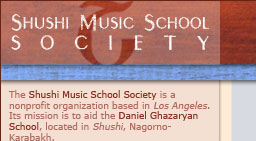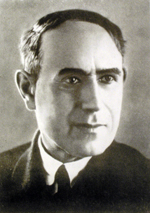



History
Daniel Ghazaryan (1883-1958)
Daniel Ghazaryan is one of the most well-known Armenian composers who has also earned his fame as a conductor, teacher, and the father of Armenian children’s music revival. He was born in 1883 in the City of Shushi. Both of his parents were teachers. He received his primary education at the Shushi elementary school and his professional vocal training under the guidance of the renowned professor Petrov. Daniel Ghazaryan started his career as a choral conductor. While he was still a student at the conservatory, he organized choirs of blue-collar workers in neighboring regions. He worked as a highly respected children’s music instructor for over 50 years. The music curriculum he prepared was followed by many generations of teachers. |
 |
|
In 1933, through the vision and hard work of this master, a new artistic era began for the Children’s Opera of Yerevan. Masterpieces such as Ghazaryan’s “Haghtvatz Bazen” and “Gaileh”, Muradyan’s “Shunn u Gadoon”, Umr-Shadi’s “oolignereh”, Mailyan’s “Dignig-Zizigeh”, Manookian’s “Chari Verjeh”, and many other children’s operas were performed regularly and for years thereafter. His legendary methods guide teachers today at the Daniel Ghazaryan School. Shushi through the Ages Shushi, (also known as Karagloukh, Kar) is located in the Varanda province of Nagorno-Karabakh. The City is situated 1600 meters above sea level on the banks of the Karkar River. In the mid 18 th century, Shushi became a city-fortress and by the 19 th century, a political, commercial and cultural center. From the very day of its foundation, Shushi knew little peace. Indeed, throughout its history, fierce battles have taken place around the city between Armenian, Persian, Turkish, and Russian armies. Since the beginning of Christianity, prominent spiritual centers situated close to Shushi, such as Amaras and Gandzasar, played very important roles in the history of the Armenian culture: the monastery of Hovhaness Mkrtich of Gandzasar (1238) for instance, has been the residence of the Catholicos of Armenians for the Eastern Region for centuries. During the period from 1820 to 1920, Shushi was renowned for its educational centers. Many of them, such as the Armenian Eparchial School of Karabakh, The Girls’ College of St. Mariam, the Municipal College, and the Gymnasium of Mariam Goukassian, were well known beyond the boundaries of Shushi. During this period, 21 Armenian newspapers and magazines were printed and published in the city. Shushi has played an important role in the development of the Armenian folk music. Generations of “Ashough” from the Chichian Family took residence there and gave the city its reputation as the “Transcaucasian conservatory” at the beginning of the 20 th century. The Golden age of Shushi which lasted more than one hundred years, ended on March 23, 1920, when Turkish and Azeri mobs set the city on fire. Thousands of houses were burnt down and the majority of the 35,000 inhabitants were slaughtered. Thereafter, Shushi gradually became a bastion of Azeri Turkish culture. Soviet authorities, which had redrawn the map of the area and placed Nagorno-Karabakh under Azerbaijan’s rule, moved Karabakh's capital city to Stepanakert. During the Soviet era, overt violence became less frequent, although the Turkification process continued as Armenian cemeteries were intentionally uprooted, churches desecrated, and cultural monuments allowed to fall apart. |
||